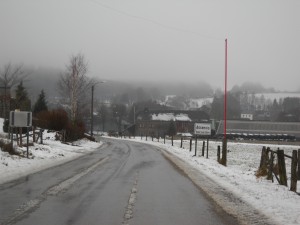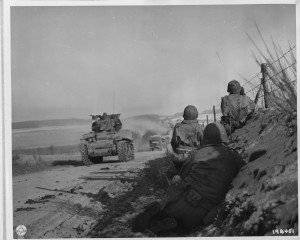For the citizens of Assenois, the arrival of the German forces was the worst Christmas present imaginable. Assenois had little appreciable military value. It did not sit atop high ground, nor was it a highway hub like its neighbor to the north, the town of Bastogne. Its location was astride a road that linked Bastogne with the town of Remichampagne, which was south of Assenois. Other than that, it was meaningless.
One of the matriarchs of Assenois remembered those dark days. Her name was Madame Denyse de Coune, and she owned a chateau along the northern outskirts of town. With several arched gables and thick stone walls, the great house looked more like a quaint castle. Since it was a large building, it had a several cellars, and as a result, when the fighting drew closer to Assenois, many area families sought refuge under its stone walls. The shelling had started on Wednesday evening, the 20th of December, and for the next twenty-four hours, the battle see-sawed back and forth, but by the morning of the 22nd, the Germans were in control of Assenois and had pushed westward. For all the fighting, the cost was to the town was minor: only one civilian lay dead.
On the 23rd, a German feldwebel (sergeant) from Vienna had approached the matriarch and asked her if they could set up an office within the chateau. Thirty minutes later, he and his staff section were gone, but another unit replaced them. As it turned out, the staff of the 39th Fusilier Regiment also wanted a comfortable locale for their headquarters. With its dense walls and subterranean vaults, the German volksgrenadiers had decided that it was a great spot to command and control their regiment. Oberstleutnant Walter Kaufmann, the commander of the 39th Fusilier Regiment, and a Oberleutnant Specht, the commander of its 1st Battalion, agreed, and they moved in once the phone lines and radio transmitters were active.
Unbeknownst to the Madame de Coune, the 39th Fusiliers were part of a much larger operation. For several days, the 39th, together with the rest of its division, the 26th Volksgrenadier, had been locked in combat with the 101st Airborne Division, trapped inside Bastogne. The Germans needed to capture the town to dissipate the traffic jams, which were clogging up their supply lines. So far, the 101st successfully had resisted every German attempt to seize the vital road net. More important, the Germans were running out of time because Lieutenant General George S. Patton’s Third Army was pushing its way north towards Bastogne. In fact, Assenois was one of the towns that were between Patton and Bastogne.
By the 24th, the Germans were everywhere inside the chateau, as if they had been living there for years. Even worse, the growing presence of German vehicles and troops outside the house made it a tempting target for the American P-47 Thunderbolts, flying above them like birds of prey. As evidence, one group of fighter-bombers strafed the building on Christmas Eve day, but thankfully, the sturdy walls were too much for the bullets, which bounced harmlessly off them like rain drops. Walls, though, would be useless against bombs.
That night, while everyone in the Christian world celebrated Christmas Eve, the German soldiers stole some of the chickens from the de Coune farm for their own Christmas feast. Another landser (German term for soldier), out of kindness, brought American biscuits to feed the hungry children. No doubt, the soldier had found them, since the German soldiers had little food from their own supply chain. To keep up morale, the refugees then sang Christmas carols to each other while the parents regaled their children with stories of the Comtesse de Segur, who was a Russian born, French novelist.
The following Christmas morning started out well. Mrs. Augustus de Coune baked some bread and served it with roasted chicken. As the morning dragged on, more and more refugees arrived, and they were not the only ones seeking shelter. By midday, more German soldiers showed up, demanding sanctuary from the American bombs and artillery. Hearing this, Madame Denyse de Coune shook her head in dismay because she knew the corridors were overcrowded. Someone had to go, and the German soldiers ejected her and the rest of the civilians.
Like Babylonian exiles, they grabbed whatever they could carry. Most only brought a blanket and some bread, and they left for nearby sand dunes, which had been a hideout for the resistance during the long German occupation. When they arrived, they discovered that the shelters were gone. For the next thirty hours, the refugees would be homeless. At least, thought Madame de Coune, the frozen pine trees looked like Christmas trees. That night, they slept under the stars like the shepherds outside of Bethlehem. Nearby, the Germans had set up an artillery battery, and it was firing at the American forces in Bastogne. The paratroopers replied with their own counter battery, and the rounds from the American artillery fell dangerously close to the refugees.
Meanwhile, the tankers and infantrymen of Combat Command Reserve of the 4th Armored Division prepared themselves for combat. They had been fighting almost non-stop since the 22nd of December, and now they were closing in on the prize – the town of Bastogne. While Madame de Coune and the other banished families huddled in the freezing cold, Lieutenant Colonel Creighton W. Abrams, the commander of the 37th Tank Battalion, was leading a combined-arms task force. Several hours earlier, Abrams’ men had captured the town of Remoiville, which was three kilometers south of Assenois.
The following morning, the 26th of December, Abrams began the final drive into Bastogne. First, they overran a German panzergrenadier company in Remichampagne. By noon, Abrams’ forces were just to the south of Clochimont. Only the town of Assenois was between his tankers and the beleaguered paratroopers in Bastogne. Alas, most of the inhabitants of the small village were recent arrivals from the 39th Fusilier Regiment, ensuring that the ride through Assenois would be fraught with danger.
Outside of the town, Madame de Coune watched the beginning of Abrams’ historic assault. In preparation for the final push, P-47 Thunderbolts swept over the town, plastering it with napalm while showering the German defenders with lead from their eight, blazing .50 caliber machine guns. Explosions rocked the forest where the refugees were hiding, causing the trees to tremble and shed their snowy blankets.
After the Thunderbolts, the twenty-six exiles next watched a procession of C-47 transport planes pass over them. Then, like manna from heaven, hundreds of parachutes began to appear, as aircraft crews delivered supplies to the surrounded paratroopers. Luckily for the families, which included seventeen children, many of the para-packs were stuffed with biscuits, cheese, and best of all, chocolate. For the hungry refugees, the food lifted their morale.
The feast did not last long. Towards the end of the afternoon, Madame de Coune watched as a column of American tanks and halftracks lined up south of Assenois. Then, with guns blazing, the column snaked its way through the narrow village streets and broke through to the other side. She described the vehicles as “spitting fire.” Next, she saw the American forces push the German defenders eastward and into her neighbors’ homes. Now, it was the Americans’ turn to surround the Germans. Some fought, but most of them eventually surrendered.
By early evening, Madame de Coune reckoned the fighting was over, and she led the exiled families back into Assenois where they discovered that her home had not escaped the fighting unscathed. Four artillery shells had penetrated the roof, leaving gaping holes for the rain and snow, and the same shells shattered many of the windows. Despite this hardship, the families of Assenois were once again free. The tankers and infantrymen of the 4th Armored Division had liberated them.


submitted by by Leo Barron, Associate
